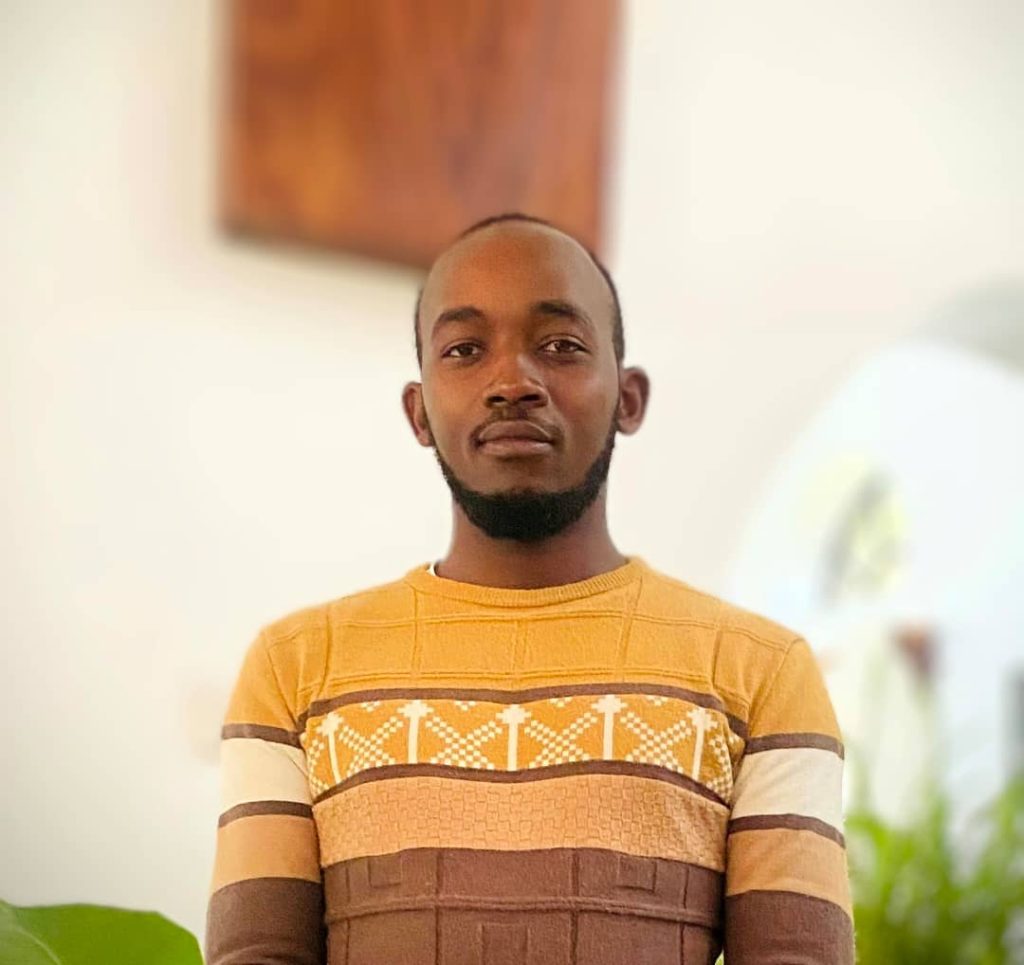“How do you breathe life into the letters on the paper?” The MC asked Neema during a writers’ conference.
Despite her recovery efforts over the past 14 months, tears welled up in her eyes.
***
That night, as the car slammed into a pothole, Neema saw her life flash before her eyes. The front tire burst and flipped in the air. She jolted. The car fell flat on its face in the middle of the highway. Other vehicles hit and tossed it around, crushing it. Neema yelled out to the road, the driver, and the car. What else was left for her except the instinct of hanging on tightly, hoping? In a few seconds, everything turned black.
She had started the day perfectly, ready to conquer mountains in Rwanda’s fashion industry. She had put on a white jumpsuit, black high heels, and a white feathered hat. Her long hair fell back on her shoulders. She had previously sealed deals with local luxury brand Tamu-Tamu and a modelling agency, Black Beauties. She was over the moon. Her dream had just begun to become a reality.
Regaining consciousness, Neema found herself in a white room, people surrounding her, others moving in and out. She felt as though she was pinned to the ground — as if a heavy sack was placed on her chest. Then someone said, “She’s back.” Neema attempted to ask for clarification but failed to let out a word. She couldn’t even twitch her fingers, let alone lift her legs. She could only feel excruciating pain all over her body and couldn’t decipher what was happening. All she remembered was how the car flipped and a modelling contract she didn’t sign.
Her mom was there, seated on the side of the bed, sobbing. Neema was on breathing support. Bandages swathed her head, and her legs were immobilised with medical supports.
A few weeks later, her wounds started healing. She underwent a medical checkup. When it was time to hear the results, the doctor invited her and her mom to his office. He sat on a chair behind his desk and projected some medical images on the wall. “You can see that the injuries on the head are completely healing,” the doctor said. “There is no brain injury, and that is very good news. The back is intact, which rarely happens in accidents like the one she had.” Neema and her mom were pleased to hear that until the doctor said, “There is one big issue though.”
“What is it, doctor?” Neema’s mom asked, worriedly.
“The injuries on her left leg damaged the neurons and nerves responsible for coordinating the leg with the brain. There is no treatment for damaged neurons and nerves so far. That means, the leg won’t be able to be used anymore. I am so sorry,” the doctor explained.
Neema’s heart sank and tears welled up in her eyes. How could she model without a leg? How could she participate in any beauty pageants? Her dreams were in vain just when she was about to reach them. Her mom held her tight, assuring her that they would walk through everything together. She was her only support system. Family members visited her in turns, but most of the times, she was with her.
“So what options do we have?” Neema asked the doctor.
“There are some viable options. We can amputate the whole leg and replace it with an artificial one. This can allow you to walk on your own, but not as smoothly as with the real leg. That is the number one option, but it is very expensive and you might need to go overseas to have the operation done. Other options are to use crutches or a wheelchair,” the doctor explained.
“You mean there is no other way I can be treated and use my leg?” Neema enquired.
“I am so sorry, Neema. There is no treatment for damaged neurons and nerves,” said the doctor.
Tears welled up in Neema’s eyes. Her mom returned her to the hospital’s waiting room. She had no appetite for anything. She felt like she was not worthy to live anymore. She had lost her only dream and couldn’t understand why.
Her leg was amputated a few weeks later, and she started using a wheelchair and sometimes clutches. She spent two more months at the hospital recovering. She started relearning how to use her arms and other parts of her body that had been injured. During that period, she only used her phone where necessary, mostly to communicate with her mom. She moved around the hospital in a wheelchair with the help of her mom. The fashion industry had moved on. Her contracts were nullified. She realised she had to start from scratch should she want to continue her modelling career. She was dismissed at the hospital three months after the amputation operation.
Over time, her physical health improved, but her mental health kept deteriorating. She became emotionally distant from her mom, and her lively smile faded away. Her words became fewer and fewer. She abandoned her phone at all costs. She asked her mom to destroy all her beautiful dresses, give away all her high heels, and destroy the awards she had won in fashion and local pageant contests. She cut her hair and vowed to never wear makeup again. Her mom insisted on helping her to brighten her day, but she never wanted anything that could remind her of her beauty, fashion, and modelling career. She was depressed. Her mom was even more depressed, although she couldn’t tell. She had lost her husband in an accident when Neema was a few months old. Now that another accident crippled her only child, she felt as if the universe had cursed her family.
But she was a fighter. Although Neema initially resisted her advice to attend any counseling session, she finally convinced her to. One morning, she ushered her to the hospital to meet Faith, a clinical psychologist. Arriving there, Faith welcomed them with a bright smile. Her room consisted of two bookshelves, a pot of roses, and a cup full of pens and crayons. Neema loved staring at them.
“Mama Neema,” said Faith. “If you would excuse us, we will take at least an hour. Feel free to stay in the waiting room, reading a book, or even go to the flower garden. Just anything you feel comfortable with.”
Neema’s mom exited the room and closed the door. Faith opened her book. “What are your hobbies? I would love to know more than just a name,” she asked Neema.
“I don’t have a hobby anymore because I am not living my life.”
“I understand, honey. I bet you don’t live your life anymore.”
“Okay! So, how many times will I have to come here before you release me?” Neema asked.
“It depends on how fast you can adapt to the healing process. Some need to come in a couple of days, others take like three months, but it is always worth the time. We all experience heartbreak at some point in life so we need to mend our broken hearts to continue on this journey of life,” Faith explained.
“Okay. Then I am prompted to ask you if you are just here because you receive your checks. Otherwise you wouldn’t waste your time listening to the ruined lives of others. It’s just a profession, right?” Neema asked.
“I wish that was true then life would be just easy, and maybe I would even go to other places where I can earn more than what I earn here. But there is a bigger reason behind it,” Faith said and flashed a genuine smile.
“And what is the reason?”
“I guess if you are very interested, you will eventually find out, but for now, let’s begin.”
“Okay, fine. How many minutes remaining, by the way? I remember you said one hour?”
“Just a few minutes. I’m sure you will like the process overtime.”
Neema was relieved. Faith grabbed a book and asked her to close her eyes, which she did.
“Think about yourself. Imagine standing in the best place that you love. Look around and describe what you see,” she said.
Neema started visualising herself standing in a fashion showroom, wearing designer clothes, moving majestically as she always did whenever she modelled. The crowd was cheering, taking pictures of Neema with their phones. A smile etched itself onto her face. Since the day of the accident, it was her first time she reflected on her life again.
“Can you imagine yourself five years from now and describe to me what you see?” Faith asked her, bringing her back from her fantasies.
Neema tried to imagine the future, but nothing came to mind. Faith asked her to describe what she was seeing. It was darkness. She was standing in a dark valley, something like an open hall, all alone, and she couldn’t even identify herself. It was pitch black, with no emotions. There was nothing going on.
Then Faith asked Neema to open her eyes. She had taken a few notes of her responses.
“It’s very hard to lose your dream and the purpose of life,” she said. “This is a kind of trauma that leads to suicidal thoughts. When the only reason to live is taken away from you, then what is the meaning of life? When you described the place you love the most, you smiled because you were living your dream. But when I asked you to describe the future, there was nothing because, in actual sense, your dream is gone, taken away completely.”
Neema burst into tears. She mourned for her dead dreams, and some weight lifted off her heart. Faith patted her back and said, “Dreams do come true, not in one way. There are a million ways they can come true. If one way fails, there are other ways a person can try out. Stars shine always, even in the day, but we see them bright and beautiful in the darkness.”
As she spoke, something like scales fell off Neema’s eyes. She cried. She never realised it, but she spent one more hour talking to Faith. She even booked an appointment before going back home with her mom. She was somehow in a lighter mood. She could feel she was making a good step.
Over the following months, Neema had many therapy sessions with Faith in which they ended up sharing their stories. Faith was a wounded healer. She was passionate about her work because she could relate to those who sought her help and was determined to help everyone to find their way back from depression and brokenness. Throughout the process, Neema started accepting her changes and integrating herself back into society. Nevertheless, she still hadn’t found something else to replace her modelling career. More often than not, she would fall into a ditch of depression again because she couldn’t figure out anything else to do.
In one particular session, Neema asked Faith a question that had always been on her mind. Having spotted so many books in her room, she had never seen her read any of them. So she asked why.
“In case you haven’t noticed, I have replaced quite a few of them since you came. I love reading books, and I am a writer myself,” she answered.
“Oh, wow! Well, I don’t like reading. I don’t enjoy all those fictional things, imaginary things, or fantasy worlds. I love real stuff.”
“Oh! Maybe you have been introduced to the wrong genre or set of writings,” said Faith. “But the truth is, I also don’t like reading fiction or fantasy. I love reading books based on real stories. I love learning about the world through the stories of others, and there are quite interesting stories in all industries and parts of the world.”
“Really? Do we also have books about fashion, models, and other related stuff?” Neema asked.
The only thing she knew was Instagram, TikTok, and other social media platforms. It never crossed her mind there could be books about fashion.
Faith pulled out a copy of Elle, one of the top magazines in the world that focuses on women’s fashion. Neema saw fashion celebrities on the cover. She was surprised that Faith, as calm as she looked, knew anything about fashion.
“I don’t particularly like fashion that much, but I keep a handful of different writings to learn about something. Anyway, did you know that anyone can be a writer? In fact, you can be a writer,” she told Neema, her gaze firm.
Neema laughed hysterically, but Faith didn’t. She was serious. She advised Neema to start using social media again. She encouraged her to write and share her story as a way of healing and exploring other opportunities available for her. Neema borrowed her advice and ended up spending many hours writing stories about her journey in the fashion career. She also shared a few pictures, starting from the ones she felt comfortable with – those before the accident, including the ones she had shared in the past. She even touched slowly on her accident and how it turned her career upside down. She was amazed by how supportive the public was. Her followers encouraged her to share some of the details of her story and how she fell into depression. She heard them and complied. She realised she wasn’t the only one whose dreams and passions were crushed by tragedies. People could relate with her story and were inspired.
As she regained active engagement on her social media, she sought advise from Faith. Faith advised her to turn her stories and posts into a book. She promised to help her navigate the process. Neema had already written many stories, notes and journals that she shared on her platforms. She compiled and refined them. She even added the missing parts, giving the story depth and authenticity.
Seven months later, she published a book titled “Dreams Reborn through Being Crushed.” Many people bought the book as a way to support her. Thousands of copies were sold nationally and internationally. Following the success, Neema started a fashion magazine that featured stories almost the same as hers — of broken dreams as well as upcoming models. The magazine was even a bigger success, gaining publicity and being rated among the best in the region. It spotlighted models from their humble beginnings and how they progressed to stardom.
Neema’s book was nominated for the National Book Award, and since then, her career skyrocketed, writing different books about fashion, dreams, and the power of authenticity. Her magazine and books became like a double-edged sword towards her success. The magazine promoted her books, and her books promoted the magazine by featuring different human-interest stories.
Neema attended a writers’ conference when she was a national bestseller. That is when the MC asked her, “How do you breathe life in the letters on the pages?” during an open discussion.
“I picked up all the pieces of my broken dream, and each broken piece made a converse of scripture. An entirely new dream was born, and all the pieces collectively made a foundation for me to make my dreams come true,” she responded, tears welling up in her eyes.
“Tell us more,” urged the MC.
“Look, I only dreamed of being featured in an international fashion magazine; I never thought I would own a successful one. I only thought I wanted to succeed as a model, but I never knew I would be the reason many models succeed. And so I draw from the cracks of my heart and life, and I always find enough water in those cracks to quench my thirst in life. If you embrace your brokenness, you will understand your wholeness. Only through living fully can we be able to leave a legacy. It is just our true stories encouraging the pilgrims of this life to navigate it with courage,” she said, and a smile played on her lips.
A round of applause filled the air.
ABOUT THE CONTRIBUTOR

Patrick Iradukunda explores themes of pain, suffering, love, hope, and resilience through poetry, short stories, and children’s literature. Writing helps him channel a positive world outlook and inspire hope. Outside of writing, he is dedicated to working with underprivileged communities, including refugees, farmers, and children, always aiming to make a positive impact.



